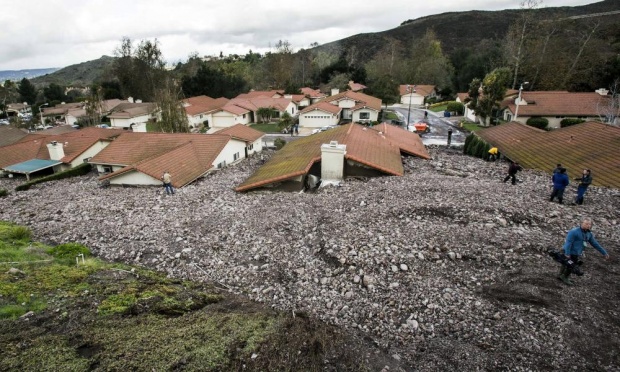We can't let climate change turn droughts, flash floods and mudslides into the new normal
PhD, Conflict Analysis and Resolution, George Mason University
M.A, Conflict Transformation & Peacebuilding, Eastern Mennonite University
|
|

Holding out for winter rain or implementing short-term fixes won’t fix California’s water crisis. We need action on the state, federal and international level.
Between power outages, deluging rains, flash floods, mudslides and record droughts, California is quickly becoming unrecognizable – all the bellwethers of an ecosystem out of whack. Thanks to a rapidly changing climate making wet regions wetter and dry regions drier, 2014 will be the hottest year on record – and, if we’re not careful, the Bay Area’s recent #HellaStorm will soon become the norm.
Everyone in the state knows the severity of the problem: we’re in the midst of our worst drought in 1,200 years; our winter snow pack, which provides approximately one-third of the state’s water supply, was at record lows in 2014; last winter’s weather was the warmest in the last 119 years; and ocean surface temperatures off the coast of California are at record highs. The wrath of a warming planet is being felt more powerfully than ever before.
Unfortunately, within the halls of Congress and across California, there remains a misguided belief that we can legislate our way out of this drought. But short-term fixes like piping enough water from one locale to another or conservation and efficiency measures, won’t be sufficient to address urban and rural water shortages – and no amount of Pineapple Express rapid rainfall will fix the over-tapped and exhausted water supply. Both will be a mere drop in California’s near empty bucket. Furthermore, short-term fixes for this water crisis don’t address the long-term problem of climate change, which is causing this crisis and will undoubtedly cause more.
This is not simply a California problem. California supplies nearly half of all U.S. fruits, vegetables, and nuts, so any drought directly impacts the diets of all Americans. And the state is not solely culpable for its own climate disaster, nor can it fix them by itself: heavy carbon dioxide emissions, whether from the East Coast or East Asia, are contributing to the extreme weather that California is now experiencing.
The good news is that 2014, while being the hottest year on record, also saw unprecedented public and political support for action on climate change. Most Americans now recognize that climate change is happening, are willing to pay more for cleaner and greener energy, and are keen to vote for candidates who will take action on our climate. The 400,000-person People’s Climate March in New York, timed with the UN Climate Summit in September, illustrates the public’s appetite for aggressive action.
Meanwhile, the historic US-China climate deal and the commitment by the European Union to reduce their emissions 40% by 2030, are excellent examples of worldwide leadership. Even in the halls of Congress – traditionally not the friendliest space for environmental policy – climate change is now a bipartisan, and both Republicans and Democrats are speaking out and taking action. There’s even a conservation-minded group of members of the Tea Party movement called the Green Tea Coalition pushing for more investment in solar power.
The critical next steps to save California – and every other state of the union that will witness extreme weather in the coming years – from the effects of climate change requires work by federal, state, and local governments – and close coordination with the private sector.
Achieving the US government’s goal of reducing emissions 80 percent by 2050 – which is necessary for us to survive this century – requires: a steady transition to renewable energy; a phase-out of dirty fossil fuels and the subsidies that support them; the pursuit of low-hanging conservation and efficiency initiatives in transportation, infrastructure, and utility sectors; and a national campaign to get the public thoroughly on board.
There is no more patriotic pursuit than reversing climate change and its effects. Our national security depends on it, since climate change is a threat multiplier, making unstable regions even more insecure and potentially violent. Our health depends on it, as extreme weather is already killing thousands of Americans each year. Our economy depends on it, as myriad billion-dollar natural disasters are destroying our economic infrastructure and devastating industries.
The time to act on climate is now – before another #HellaStorm becomes #HellaCommon.
This material is presented as the original analysis of analysts at S-CAR and is distributed without profit and for educational purposes. Attribution to the copyright holder is provided whenever available as is a link to the original source. Reproduction of copyrighted material is subject to the requirements of the copyright owner. Visit the original source of this material to determine restrictions before reproducing it. To request the alteration or removal of this material please email [email protected].
rosters
IMPORTANT LINKS
- Home
- Admissions
- Academics
- Research & Practice
- Center for Peacemaking Practice
- Center for the Study of Gender and Conflict
- Center for the Study of Narrative and Conflict Resolution
- Center for World Religions, Diplomacy, and Conflict Resolution
- Indonesia - U.S. Youth Leadership Program
- Dialogue and Difference
- Insight Conflict Resolution Program
- Parents of the Field Project
- Program on History, Memory, and Conflict
- Project on Contentious Politics
- Sudan Task Group
- Undergraduate Experiential Learning Project
- Zones of Peace Survey
- News & Events
- Student and Career Services
- Alumni
- Giving




